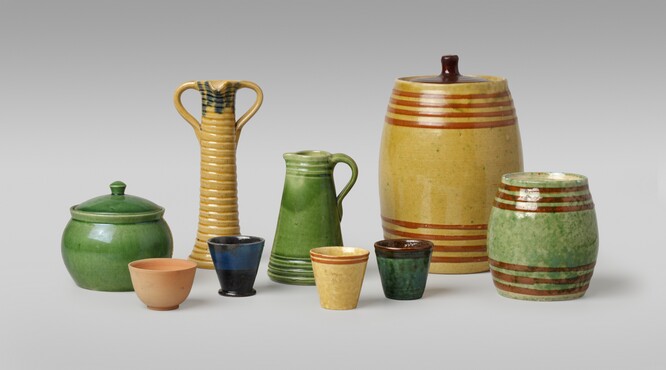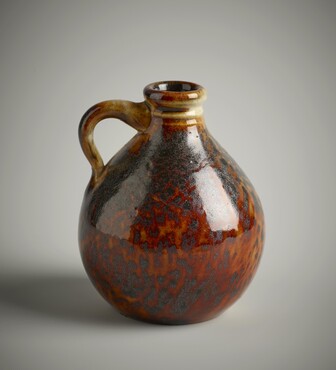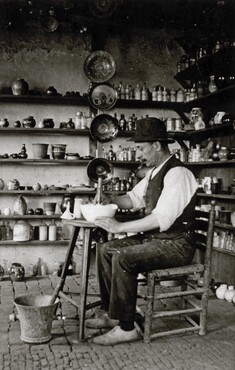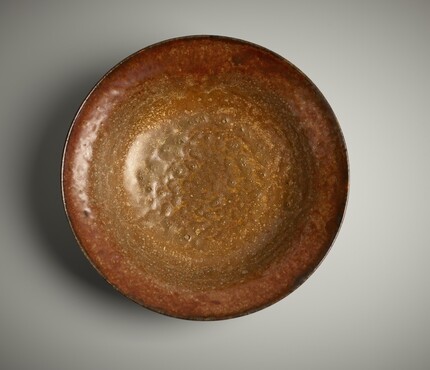Ontdek de collectie
Kunstmuseum Den Haag has a treasure chamber of over 160.000 pieces of art. Here we work on making the highlights from this collection available online.
Hein Andrée
Craftsman Becomes Ceramic Artist
Hein Andrée (1882 – 1961) has now fallen into obscurity, but in his day the ceramic artist was famous for his astonishing technique. From 22 October Kunstmuseum Den Haag shows 120 objects spanning his entire body of work, whose great charm lies in the unique way they combine technical skill with an artist’s eye. The objects are from private collections and have never before been displayed to the public. They will be shown in display cases that were specially designed for displaying ceramics when the museum was built in the 1930s.
From craftsman potter to ceramic artist
Hein Andrée began his career in the late 19th century as a craftsman working at his father’s pottery, which produced simple everyday items in series. As a result, Andrée fashioned the same shapes countless times, turning the same types of pot day in, day out. It is said he was able to produce 1500 plant pots a day. Despite this incredibly rate of high production, Andrée had greater artistic ambitions. Slowly but surely he started making more decorative objects. His knowledge, skill and sublime technique enabled him to create objects of astonishing refinement: his small pots and vases became almost minuscule, with unbelievably thin walls, making them unsuitable for practical use, but highly attractive to look at.
Testing and glazes
Andrée also began to turn his attention to unusual glazes, leaving nothing to chance. Although virtually impossible when making ceramics and firing objects, Andrée attempted to retain full control of the form, colour and texture. While the aesthetics of his objects suggest an artist who embraced random outcomes, Andrée’s method was that of a craftsman who actually sought to exclude this by testing, and by relying on his knowledge and skill. This distinguishes him from better-known fellow ceramicists working at the same time, like Chris Lanooy and Willem Coenraad Brouwer.
Experimenting in the witch’s cauldron
His studio almost became a chemistry lab, or witch’s cauldron, as Andrée put it. He mixed his pigments himself and carried out many tests. Numerous objects on which Andrée experimented with coloured glazes have survived, and some of them will be shown in this exhibition along with a large number of unglazed pots, probably produced as Andrée explored how thin he could make them.
Natural phenomena and materiality
Andrée’s ceramics with glazes imitating natural phenomena are quite extraordinary. His astonishing ability to retain control allowed him to create objects that appear to be covered in snakeskin or tiger fur, while others resembled snow or a lunar landscape. But he also played with materiality, creating ceramics that appear to be made of gold or copper. One highlight of his oeuvre is a red-brown ceramic plate with indentations that looks as if it were made of hammered metal.
Incredibly small vases
Towards the end of his career Andrée was greatly inspired by white Delftware and historical Japanese, Chinese and Korean ceramics, which he encountered through collectors of his work. As well as the white colour and the distinctive oval and globular forms, he also imitated the dimensions of these pieces and, from the 1930s especially, began creating incredibly small objects. Many of his vases are less than 10 centimetres tall.
Hein Andrée: Craftsman Becomes Ceramic Artist, on show at Kunstmuseum Den Haag from 22 October 2022 to 7 May 2023, will showcase work from Andrée’s entire career.






